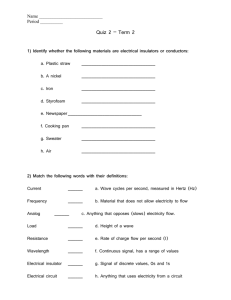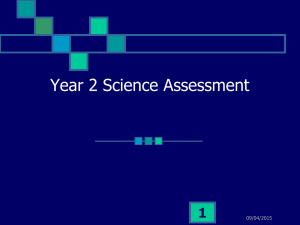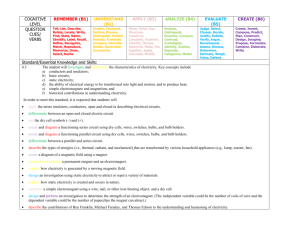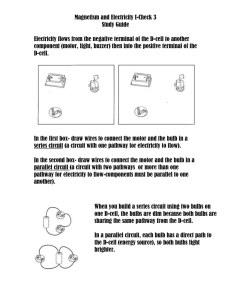Creating a Simple Circuit-- Lesson 1
advertisement
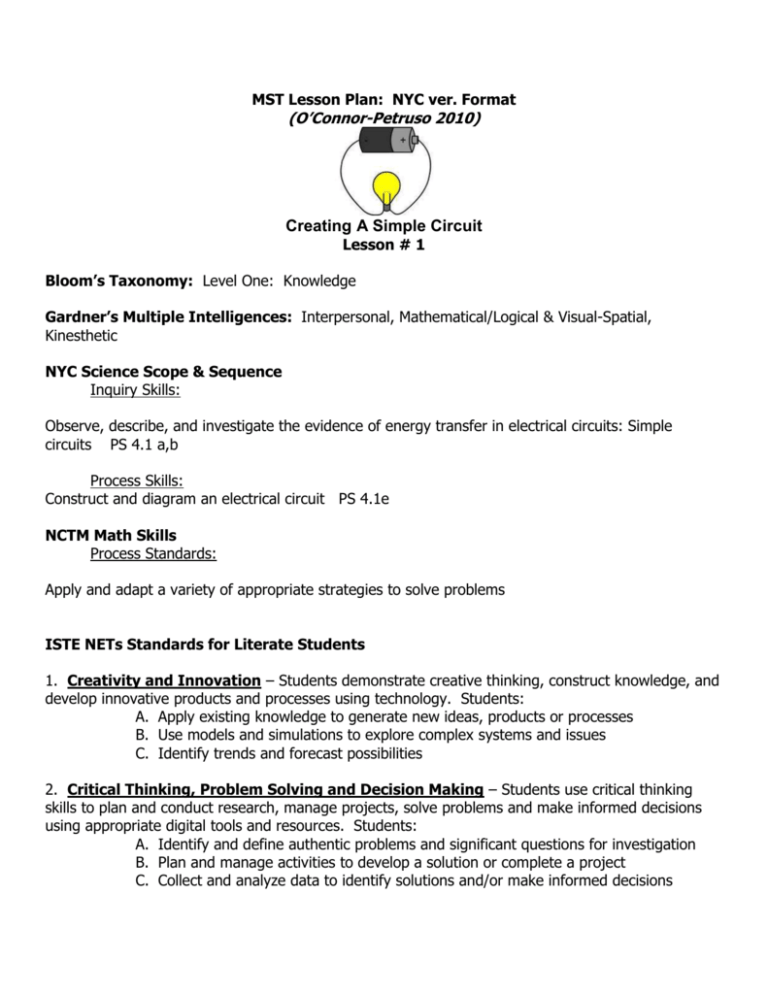
MST Lesson Plan: NYC ver. Format (O’Connor-Petruso 2010) Creating A Simple Circuit Lesson # 1 Bloom’s Taxonomy: Level One: Knowledge Gardner’s Multiple Intelligences: Interpersonal, Mathematical/Logical & Visual-Spatial, Kinesthetic NYC Science Scope & Sequence Inquiry Skills: Observe, describe, and investigate the evidence of energy transfer in electrical circuits: Simple circuits PS 4.1 a,b Process Skills: Construct and diagram an electrical circuit PS 4.1e NCTM Math Skills Process Standards: Apply and adapt a variety of appropriate strategies to solve problems ISTE NETs Standards for Literate Students 1. Creativity and Innovation – Students demonstrate creative thinking, construct knowledge, and develop innovative products and processes using technology. Students: A. Apply existing knowledge to generate new ideas, products or processes B. Use models and simulations to explore complex systems and issues C. Identify trends and forecast possibilities 2. Critical Thinking, Problem Solving and Decision Making – Students use critical thinking skills to plan and conduct research, manage projects, solve problems and make informed decisions using appropriate digital tools and resources. Students: A. Identify and define authentic problems and significant questions for investigation B. Plan and manage activities to develop a solution or complete a project C. Collect and analyze data to identify solutions and/or make informed decisions Behavioral Objectives: 1. To build simple circuits with a focus on how simple connections are made. 2. To identify the essential components of an electrical circuit 3. To demonstrate evidence of the flow of electricity Children’s Literature: Illuminating Teamwork from FOSS Science Stories: Magnetism and Electricity Web Resource: Brainpop.com—video on electric circuits Graphic Organizer: K-W-L Chart “Motivation/Constructivist Activity:” Tell students that the class will be discussing electricity and that they will be able to make their own electrical circuits. Have students access their prior knowledge by asking where electricity in their house comes from and then ask how they use electricity. Time Duration: Day 1: 10 minute assessment time Day 2: (1) 60 minute period Procedures: 1. The day before instruction begins the teacher gives students an electricity assessment. (See Appendix A) 2. Gather the students at the meeting area. Create a K-W-L chart about their knowledge of electricity and circuits. 3. Continue the lesson by reading Illuminating Teamwork from FOSS Science Stories: Magnetism and Electricity. Teacher will read specific excerpts from the story. This story is told from the perspective of Thomas Alva Edison. He talks about his work but more specifically he talks about light bulbs, how they work, and the flow of electricity to them. 4. Show the battery to the students. Introduce the D-cell. 5. Show the light bulb to the students. Introduce the light bulb. 6. Tell the children that they are going to have a challenge today. They are going to have to move the electric energy from the electricity source (the battery) to the light bulb. 7. Hand out materials to groups. Students will work in pairs. 8. Teacher walks around as pairs of students use trial and error to get the light bulb to light. 9. After everyone has been able to light the light bulb ask the students the following questions- How did you connect the wires to the battery? How did you connect the wires to the light bulb? What happens when you touch the wire to the glass part of the bulb? 10. Teach the class what an electricity receiver is. 11. Introduce what a circuit is and what its components are. 12. Class discusses how connections must be made and how electricity flows through a circuit. 13. Give assessment a second time to see how much students have learned about creating circuits. This time students will have to diagram and label components. (See Appendix B) 14. Using the Smart Board and laptop go to Brainpop.com. Teacher shows excerpts of the short movie on electric circuits to reinforce concepts explored in the lesson. Questions: I. Closed-Ended Questions: 1. Can you use a battery to turn on the light bulb? a. Yes, you need a battery and wires. 2. What is the general shape of a circuit? a. circle II. Open-Ended Questions: 1. How did working in pairs help you in this experiment? 2. Are there other ways to get this light bulb to light? Materials: For Each Group (2) D-cell, alkaline (2) light bulbs, #222 (4) short wires, 20 gauge, 15 cm (2) bulb holders (1) cell holder (4) sheets of paper (1) pencil per child For the class (1) wire stripper (1) roll of wire, 20 gauge, insulated (1) metric ruler or meter tape Smart Board Internet Access Laptop Class set of circuit worksheet Assessment: 1. Teacher will walk around during the experiment taking anecdotal notes about the students’ scientific thinking. 2. Teacher will have an informal assessment through the various discussions during the lesson. 3. Students will fill out a worksheet where they will need to diagram and label all the components of a circuit. RUBRIC FORMAT Target “3” Satisfactory “2” Unsatisfactory “1” Student correctly built a simple circuit and could explain why the connections work. Student correctly built a simple circuit. Student was unable to build a simple circuit. Behavioral Objective #2: To identify the essential components of an electrical circuit Students draw and label at least 3 out of 4 components correctly. Students draw and label at least 2 out of 4 components correctly. Students draw and label 1 out of 4 components (or less) correctly. Behavioral Objective #3: To demonstrate evidence of the flow of electricity Students light bulb was able to light and can explain why. Student’s light bulb was able to light. Student’s light bulb was unable to light. Behavioral Objective #1: To build simple circuits with a focus on how simple connections are made. Student Rating References: Delta Education (2005). Investigation 2: Making Connections. FOSS (Full Option Science System) Electrical Circuits. Retrieved from http://www.brainpop.com/science/energy/electriccircuits/ Student Performance Based Product (3) for Behavioral Objectives #2 Appendix A Name _____________________________________ Date _____________________ THE FLOW OF ELECTRICITY ••• • ••• •• • ••• •• • ••••••• •••••• • •••• ••• • • ••••••• • ••••••• • ••••••••••••• • •••••• CONNECT THE D-CELL TO THE BULB ABOVE. Use arrows to show how the electricity flows. Use large and small arrows if you need to show different amounts of electricity. Describe below how electricity flows in your drawing above. _______________________________________________________________________________________ _______________________________________________________________________________________ _______________________________________________________________________________________ _______________________________________________________________________________________ _______________________________________________________________________________________ _______________________________________________________________________________________ _______________________________________________________________________________________ _______________________________________________________________________________________ _______________________________________________________________________________________ FOSS Magnetism and Electricity Module © The Regents of the University of California Can be duplicated for classroom or workshop use. Investigation 2: Making Connections No.7-Student Sheet Appendix B Name _____________________________________ Date _____________________ THE FLOW OF ELECTRICITY ••• • ••• •• • ••• •• • ••••••• •••••• • •••• ••• • • ••••••• • ••••••• • ••••••••••••• • •••••• CONNECT THE D-CELL TO THE BULB ABOVE. Use arrows to show how the electricity flows. Use large and small arrows if you need to show different amounts of electricity. Describe below how electricity flows in your drawing above. _______________________________________________________________________________________ _______________________________________________________________________________________ _______________________________________________________________________________________ _______________________________________________________________________________________ _______________________________________________________________________________________ _______________________________________________________________________________________ _______________________________________________________________________________________ _______________________________________________________________________________________ _______________________________________________________________________________________ FOSS Magnetism and Electricity Module © The Regents of the University of California Can be duplicated for classroom or workshop use. Investigation 2: Making Connections No.7-Student Sheet
